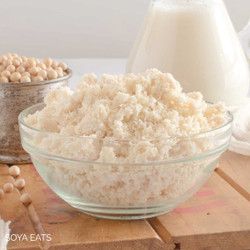When you make our soya milk recipe (made from raw soybeans), you must cook the leftover soybean pulp before using it in salads or any other uncooked recipes or in yeast recipes (raw okara affects the yeast).If you are using it to make cakes, pancakes, muffins, and other cooked recipe it can be used uncooked , because the cooking process will cook the okara.You can cook it one of two ways either; on the stovetop or in the microwave oven.
Place the okara in a large nonstick frying pan (skillet), cook it over low/medium heat, and continuously stir for about 10 minutes.
Remove from the heat and cool before storing it in an airtight container in the fridge.
Evenly spread the okara onto a large shallow microwave-safe bowl and microwave uncovered for 2 mins on high (600 watts). Remove from microwave, stir and break up any lumps. Repeat the process two more times, microwaving a total of three times.
Allow the okara to cool before transferring it to an airtight container and store in the fridge.
The above cooking methods will leave the okara feeling damp to the touch, and because it is a bit dryer than fresh okara, it gives the okara a slightly longer shelf life.
You will need one or two large baking trays with a rim. Spread the okara out on the trays in a very thin layer it has to be as thin as possible to speed up the drying process.
Place the trays into a preheated 150°C (300°F) oven and bake for 1 - 3 hours, mixing every 20 - 25 minutes until the okara has dried out.
Remove from the oven, cool, then transfer to an airtight container.
Evenly spread the okara onto a large shallow microwave-safe bowl and microwave uncovered for 2 mins on high (600 watts).
Remove from microwave, stir and break up any lumps. Repeat the process two more times, microwaving a total of three times.
Transfer the microwaved okara to a large nonstick frying pan and cook on low/medium heat and constantly stir for about 20 - 25 minutes until the mixture becomes completely dry.
Remove from the heat, cool, then transfer to an airtight container.
When dried okara looks and feels similar to fine bread crumbs, you can leave it like this or take it a step further and grind it down into a powder with a coffee grinder.
